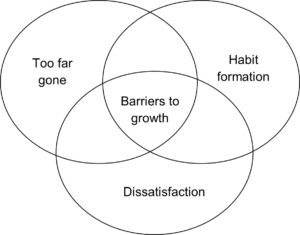The BT Approach: Ways to Move Past Barriers to Growth
Essays 2020 / Finalists
Have you ever felt like you’re too far gone, that you’ve deviated too far from the path and the way back is clouded and uncertain? How about starting a resolution only to look back two months later and not understand why you stopped? Perhaps you’ve felt so unable to shake a nagging sense of dissatisfaction that it’s led to despondency? Although these are a diverse range of feelings and scenarios, they share a central theme; the resistance met when we desire to make a change. Embedded within Chassidus are essential tools in dealing with resistance and struggles faced when striving personal growth. Broadly speaking, those looking to move past their shortcoming and who yearn for a healthier, whole, ethical, and spiritual way of living are considered ba’alei teshuvah (BT; Masters of Return). To many, the BT movement may be familiar as the transition of non-observant or non-affiliated Jews back into the fold of religious observance. However, the notion of the BT is emblematic of the universally-recognised struggle in initiating and implementing long lasting and life altering changes. Indeed, Chassidus teaches that anyone who yearns to return to a state of his/her more essential self are considered to be BT’s.
Feeling too far gone, a sense of dissatisfaction, and being unable to form habits are all examples of internal resistances we may encounter when working towards positive change and growth. The BT Approach described herein encapsulates the Chassidic methodology in navigating through these challenges towards positive growth. By targeting the central issue, of barriers to growth, various ways in which the teachings of Chassidus can help to reframe and re-evaluate these struggles will be considered.
Too far gone:
Often a major hindrance to initiating a positive change is the feeling of being beyond repair or hope, that you’re too far gone. This helpless feeling can not only stop us from achieving any true potential but can also increase discouragement or despair. How can this be viewed through the lens of the BT Approach? Within the very name; ba’alei teshuvah, lies a hint.
Teshuvah is literally translated as ‘return’. This is in contrast to a more common mistranslation of BT of one who is a ‘Master of Repentance’. This latter translation is misleading for repentance implies a self-condemnation, a sorrowful and remorseful regret of your past shortcomings and a desire to move forward towards a better you. Repenting, in the strict sense of the word, indicates a chasm of disconnect or distance which must be bridged before a reversal of behaviour can occur. In contrast, returning signifies a homecoming rather than an egress. The Tanya teaches that every Jewish soul is a ‘part of G-d above’ (1). This implies that inherent and intrinsic to each individual is the source of infinite Divine potential (2). Rather than bridging a divide through repentance, teshuvah is the act of re-joining to the inner G-dly connection that was and is always present (3). The Alter Rebbe teaches that during the act of sinning a Jew might feel unable to connect or return to G-d. However, this is an illusion as the intrinsic link and fundamental connection that the Jewish soul has to G-d is always bound (4).
Moreover, ba’al (master) implies one who has mastered something. Chassidus teaches that teshuvah is never an endeavour which can ever be said to be conclusively accomplished (5). Returning is a life-long and moment-to-moment aspiration and undertaking to live in a way more connected to Torah and mitzvot. In this way, a BT is one who has decided to initiate a change in a positive direction and continuously works in that direction. The BT Approach emphasizes that is our insensitivity to the inherent G-dly spark within us, rather than our inadequacies and imperfections which prevents us from realizing our true potential. Upon desiring to change, Chassidus reassures us that we are never too far gone. On the contrary, we never left at all.
Habit formation:
Let’s say you make a resolution to start eating healthy, cut out processed foods, go to the gym daily, and Pilates every second day. Are these resolutions ones you believe you can keep? It is known that around 88% of new year’s resolutions fail (often within the first 2 weeks) and around 1 in 10 people make too many to begin with (6). While the difficulties of habit formation are undoubtedly familiar, many still struggle with breaking bad habits and building new ones. A BT who chooses to devote his/her life to Judaic principles and observance faces this dilemma in the extreme; changing not only diet but social circles, weekend activities, pastimes, often language, and more.
Chassidus offers an answer to those looking to adopt new habits. By way of comparison, the Rebbe asks how it can be that a convert is required to keep all the mitzvot immediately upon converting but is not legally required to learn all the commandments pre-conversion (7). Surely, the convert must be thoroughly prepared before he/she converts? The Rebbe explains that the ‘Torah was not given to ministering angels (8)’. Unlike perfect angelic beings, humans are flawed and are given what we can achieve through our natural abilities. Knowing that it takes time to adopt new changes, as long as the convert is working towards fulfilment of his/her obligations they are satisfying the obligation of total mitzvah observance.
Likewise, a BT who adopts new changes and is working in a net positive direction is considered to be fulfilling her/her obligations. This also explains why the commandment to construct the Tabernacle was given six months before it needed to be constructed (9). Like buildings, habits take time to build. Thus, new behaviours or observances should be adopted gradually and incrementally over time. In a correspondence, the Rebbe advised that when it came to matters of Yiddishkeit, ‘the best method is precisely in the way of gradual conquest…rather than by means of drastic change’ (10). Indeed, overzealous eagerness can often be a main obstacle in implementing changes (11). The BT Approach reminds us that change occurs gradually and incrementally, not overnight. Yet, simply the act of making the resolution can offer some comfort, as it is taught that ‘When you come to purify yourself, heaven will assist you’ (12).
Dissatisfaction
Dissatisfaction reflects the state of discontent or disquiet one can have about their current condition or circumstance. Although it has its place, many struggle with knowing how to precisely deal with dissatisfaction, potentially leading to states of despondency, melancholia, or general unhappiness. This is a common dilemma in many cases of personal transformation and change; never quite feeling like you are or have done well enough. Should one entertain a dissatisfied state in the hope that it will generate growth or ignore all dissatisfied feelings lest they hinder progress?
Like with many Chassidic teachings, the BT Approach suggests that the answer is both. Feeling dissatisfied is seen as a positive sign as it indicates an urge to improve and grow (13). Yet, entertaining feelings of dissatisfaction without it leading to a state of growth is self-indulgence and can lead to downheartedness (14). This is likely then the work of the yetzer hara (evil inclination) which attempts to prevent a Jew from growing and connecting with Torah and mitzvot (15). This stagnating feeling of dissatisfaction should therefore be ignored. Instead, let the feelings of dissatisfaction propel you towards feelings of joy that you have managed to overcome the evil inclination and draw closer to G-dliness and positive action (16).
Tying it together
To summarize, The BT Approach is a framework by which to analyze how Chassidic principles and teachings may guide us in returning to a healthier, happier, and more spiritual way of living. Using advice given to those wishing to ‘return’ to the fold, the BT Approach has wide applicability to many issues relevant to personal transformation.
Although it may feel like the path to redemption or positive change is too off into the distance, the BT Approach reminds us that a Jew is always intrinsically and inherently connected and that the path home is always open. Secondly, taking too much on very quickly might appear to be a good choice. The BT Approach reminds us that we are not angels and as imperfect creatures we need to be aware of our natural capabilities and limitations. A better strategy is to take on positive changes gradually and incrementally. Finally, marinating in dissatisfaction will only lead to despondency and melancholy. The BT Approach reminds us that these feelings are a sign that we need to grow and to use dissatisfaction to propel us forward to live fuller and more G-d-filled lives.
Ultimately, trials and tribulations are fundamental features of life which may prevent us from ‘returning’ to the right way of living. However, just as a teacher provides the lessons before the test is given, so too Hashem gives us the tools to handle life’s tests before they are faced. Chassidus can serve as an essential guide to be able to surmount and surpass these challenges and live a life less bound to internal constraints and more connected to G-d.
(1) Tanya Ch 2: ונפש השנית בישראל היא חלק אלו-ה ממעל ממש
(2) Likkutei Torah, Parshas Chukas p. 74a
(3)Teshuvah is itself composed of the two words tashuv and Hay, meaning to return the Hay, the G-dly spark to its source. Tanya, Ch 17: והיא בחינת תשובה תתאה, להעלות ה׳ תתאה להקימה מנפילתה שנפלה אל החיצונים
(4) Tanya Ch 24: וגם בשעת החטא היתה באמנה אתו יתברך
(5) Only a Tzaddik has completely cleansed his soul from the impurity of sin. Tanya, Ch 1: צדיק וטוב לו — צדיק גמור
(6) Lehrer, J., 2009. Blame It On the Brain: The Latest Neuroscience Research Suggests Spreading Resolutions Out Over Time Is the Best Approach. The Wall Street Journal (12).
(7) Likutei Sichot, volume 35, pp. 65–69
(8) Talmud Yoma Ch 30, 1:2
(9) Ibid.
(10) Letters of the Lubavitcher Rebbe, 2 Tammuz, 5727
(11) Norcross, J.C., Ratzin, A.C. and Payne, D., 1989. Ringing in the New Year: The change processes and reported outcomes of resolutions. Addictive Behaviors, 14(2), pp.205-212.
(12) Talmud Shabbat 104.
(13) From a letter of the Rebbe, dated 16 Adar, 5712 where he quoted a sichah from the Friediker Rebbe, Pesach 5694
(14) Tanya, Ch 26: אי אפשר לנצחו בעצלות וכבדות
(15) From a letter of the Rebbe, dated 27 Teves, 5721
(16) Tanya, Ch 26: השמחה האמיתית בה‘ אלקיו הבאה אחר העצב האמיתי


